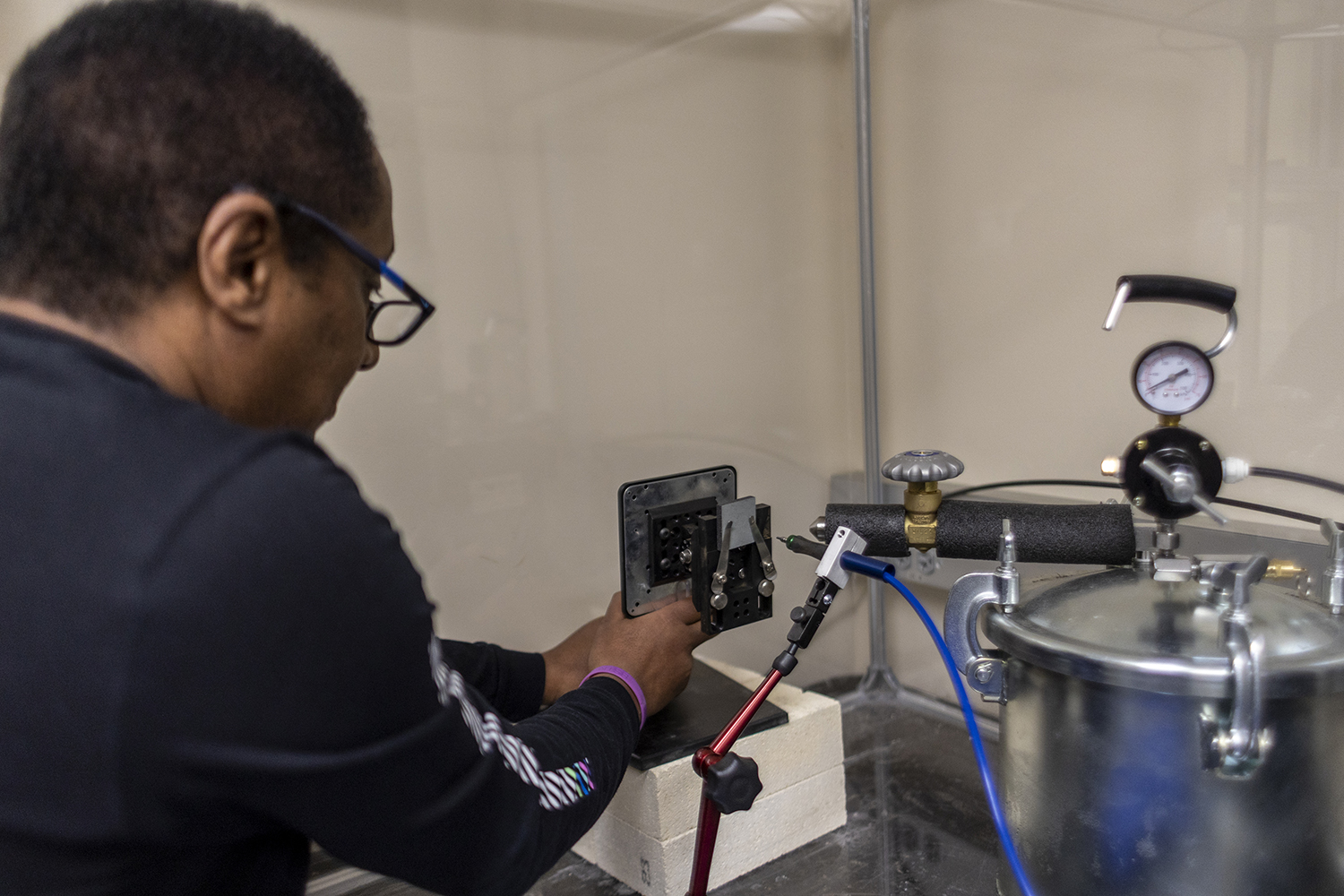Cryogenic Solid Particle Erosion
By Ted Kincaid

If you spent much time around the Engineering and Industry Building this last year, you were almost guaranteed to see UAA College of Engineering Professor Getu Hailu carting industrial sized thermoses in and out of the building. It turns out the thermoses were not for his lunch. They contained freezing cold liquid nitrogen for use in his NASA-funded research into how extreme cold affects different materials.
Back in 2019 or 2020, you may have read about a similar NASA-funded project led by Raghu Srinivasan, associate professor and chair of the Mechanical Engineering Department. He has been researching the effects of cold weather climates on material corrosion. But before you think his and Dr. Hailu’s projects are basically the same thing, think again.
While Dr. Srinivasan focuses on the terrestrial implications of natural corrosion on rocket launch facilities and other earthbound support structures, Dr. Hailu’s research is not tethered to Earth. While Dr. Srinivasan subjects materials to the ambient temperatures of Alaska, Dr. Hailu subjects materials to some seriously cold temperatures — about -300 Fahrenheit or -192 Celsius. And while Dr. Srinivasan allows Alaska’s climate and time to slowly change the chemical composition of materials, Dr. Hailu blasts his samples with incredibly fine, super-cooled particles to simulate lunar wind.
“Much research has been done at high temperatures and elevated temperature… very little is existing in the area of cold temperature, cryogenic temperatures” as Dr. Hailu characterizes his research. “When we say cold we mean cryogenic, like liquid nitrogen. We have to cool the gas to get to liquid form so the temperature should be really really low. What would be the impact of solid particle erosion if these particles are hitting the surface of a lunar vehicle on the moon under cold temperature conditions?”
In other words, Dr. Hailu researched cryogenic erosion. Since there are no repair shops in space, NASA needs to thoroughly understand all the risks before spending $433 million to send a rover to the moon. And Dr. Hailu is just doing his part.
Depending on the temperature, materials behave in very different ways. “If you have, let’s say, a metal during a sunny day it will expand and it will be softer. If it is cold, it will contract and it becomes very, very hard. Ductile versus brittle,” said Dr. Hailu.

So how do changing cryogenic temperatures impact materials? One example is your plastic garbage can. On nice warm summer days you can drop it, throw heavy things in it, maybe even run it over with your car and it stays somewhat pliable and in serviceable shape. Now, take that same plastic garbage can in the dead of winter and drop it off your porch. Now all of a sudden it doesn’t bounce back so quickly, instead it is a pile of shards on the pavement. Oops. Of course, in our observable universe we know that materials behave differently in various temperatures, but the real question is: by how much? That is where Dr Hailu came in.
“Solid particle erosion” is what he calls it. “Meaning that if you have a lunar vehicle made of some material that is being exposed to cold temperatures it will become brittle and then what will happen when that vehicle is moving in dust under that cold temperature condition?”
Dr. Hailu’s testing structure looked like an armature holding up a sample material with one nozzle spraying liquid nitrogen while another nozzle launched particles at the material.

Dr. Hailu explained, “If you have the nozzle shooting perpendicular to the target, it is shooting at one place and you get a hole. But if you have the nozzle coming at a slanted angle, usually it just pushes the material forward or you get a channel or ridge form.”
Most of the erosion is not visible to the naked eye. Rather, the damage takes the form of micro stresses. Dr. Hailu said, “Originally, you know the material’s strength, its fracture toughness, and many other specifications. Then after running the material through testing, we determined whether it retained its original strength or toughness. Because if the strength or toughness changes, then NASA needs to rethink their design. They need to ask, ‘How can we make this one wear resistant?’”
NASA has shown an interest in continued sample research. Already Dr. Hailu has visions of how to better conduct his research, upgrading his facility to be able to make precise adjustments to the temperature with additional liquid nitrogen jets and a custom designed heat exchanger for strength testing before the material enters room temperature.
Maybe sometime soon, Dr Hailu will be carting around even larger thermoses full of liquid nitrogen.









